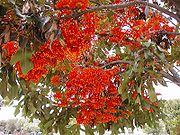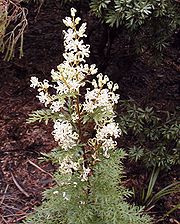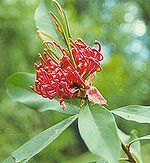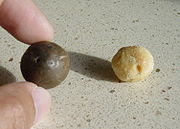
Grevilleoideae
Encyclopedia
Grevilleoideae is a subfamily of the Proteaceae
family
of flowering plants. Mainly restricted to the southern hemisphere
, it contains around 44 genera
and about 950 species
. Genera include Banksia
, Grevillea
and Macadamia
.
s, shrub
s or subshrub
s. They are highly variable, making it impossible to provide a simple, diagnostic identification key for the subfamily. One common and fairly diagnostic character is the occurrence of flowers in pairs that share a common bract
. However, a few Grevilleoideae taxa do not have this property, having solitary flowers or inflorescence
s of unpaired flowers. In most taxa the flowers occur in densely packed heads or spikes, and the fruit
is a follicle
.
, with around 700 of 950 species occurring there, and South America
also contains taxa. However, Grevilleoideae is barely present in Africa
; almost all of the Proteaceae taxa there belong to the subfamily Proteoideae
. The Brabejum
tree of Cape Town
is the exception, and the only Grevilleoid in Africa.




 The framework for classification of the Proteaceae was laid by L. A. S. Johnson
The framework for classification of the Proteaceae was laid by L. A. S. Johnson
and Barbara Briggs
in their 1975 monograph "On the Proteaceae: the evolution and classification of a southern family
". Their classification has been refined somewhat over the ensuing three decades, most notably by Peter Weston
and Nigel Barker
in 2006. Grevilleoideae is now considered one of five subfamilies of Proteaceae. The placement and circumscription of Grevilleoideae according to Weston and Barker can be summarised as follows:
Family Proteaceae
 Many Grevilleoideae species are cultivated by the nursery
Many Grevilleoideae species are cultivated by the nursery
industry, as barrier plants and for their prominent and distinctive flowers and foliage. Some species are of importance to the cut flower industry
, especially some Banksia
and Dryandra
species. Two species of the genus Macadamia
and the Chilean species Gevuina avellana
(Chilean hazel) are grown commercially for edible nuts. Chilean hazel has an acceptable frost tolerance.
Proteaceae
Proteaceae is a family of flowering plants distributed in the Southern Hemisphere. The family comprises about 80 genera with about 1600 species. Together with the Platanaceae and Nelumbonaceae they make up the order Proteales. Well known genera include Protea, Banksia, Embothrium, Grevillea,...
family
Family
In human context, a family is a group of people affiliated by consanguinity, affinity, or co-residence. In most societies it is the principal institution for the socialization of children...
of flowering plants. Mainly restricted to the southern hemisphere
Southern Hemisphere
The Southern Hemisphere is the part of Earth that lies south of the equator. The word hemisphere literally means 'half ball' or "half sphere"...
, it contains around 44 genera
Genus
In biology, a genus is a low-level taxonomic rank used in the biological classification of living and fossil organisms, which is an example of definition by genus and differentia...
and about 950 species
Species
In biology, a species is one of the basic units of biological classification and a taxonomic rank. A species is often defined as a group of organisms capable of interbreeding and producing fertile offspring. While in many cases this definition is adequate, more precise or differing measures are...
. Genera include Banksia
Banksia
Banksia is a genus of around 170 species in the plant family Proteaceae. These Australian wildflowers and popular garden plants are easily recognised by their characteristic flower spikes and fruiting "cones" and heads. When it comes to size, banksias range from prostrate woody shrubs to trees up...
, Grevillea
Grevillea
Grevillea is a diverse genus of about 360 species of evergreen flowering plants in the protea family Proteaceae, native to Australia, New Guinea, New Caledonia, and Sulawesi. It was named in honour of Charles Francis Greville. The species range from prostrate shrubs less than 0.5 m tall to trees...
and Macadamia
Macadamia
Macadamia is a genus of nine species of flowering plants in the family Proteaceae, with a disjunct distribution native to eastern Australia , New Caledonia and Sulawesi in Indonesia ....
.
Description
The Grevilleoideae grow as treeTree
A tree is a perennial woody plant. It is most often defined as a woody plant that has many secondary branches supported clear of the ground on a single main stem or trunk with clear apical dominance. A minimum height specification at maturity is cited by some authors, varying from 3 m to...
s, shrub
Shrub
A shrub or bush is distinguished from a tree by its multiple stems and shorter height, usually under 5–6 m tall. A large number of plants may become either shrubs or trees, depending on the growing conditions they experience...
s or subshrub
Subshrub
A subshrub or dwarf shrub is a short woody plant. Prostrate shrub is a similar term.It is distinguished from a shrub by its ground-hugging stems and lower height, with overwintering perennial woody growth typically less than 10–20 cm tall, or by being only weakly woody and/or persisting...
s. They are highly variable, making it impossible to provide a simple, diagnostic identification key for the subfamily. One common and fairly diagnostic character is the occurrence of flowers in pairs that share a common bract
Bract
In botany, a bract is a modified or specialized leaf, especially one associated with a reproductive structure such as a flower, inflorescence axis, or cone scale. Bracts are often different from foliage leaves. They may be smaller, larger, or of a different color, shape, or texture...
. However, a few Grevilleoideae taxa do not have this property, having solitary flowers or inflorescence
Inflorescence
An inflorescence is a group or cluster of flowers arranged on a stem that is composed of a main branch or a complicated arrangement of branches. Strictly, it is the part of the shoot of seed plants where flowers are formed and which is accordingly modified...
s of unpaired flowers. In most taxa the flowers occur in densely packed heads or spikes, and the fruit
Fruit
In broad terms, a fruit is a structure of a plant that contains its seeds.The term has different meanings dependent on context. In non-technical usage, such as food preparation, fruit normally means the fleshy seed-associated structures of certain plants that are sweet and edible in the raw state,...
is a follicle
Follicle (fruit)
In botany, a follicle is a dry unilocular many-seeded fruit formed from one carpel and dehiscing by the ventral suture in order to release seeds, such as in larkspur, magnolia, banksia, peony and milkweed....
.
Distribution and habitat
Grevilleoideae are mainly a southern hemisphere family. The main centre of diversity is AustraliaAustralia
Australia , officially the Commonwealth of Australia, is a country in the Southern Hemisphere comprising the mainland of the Australian continent, the island of Tasmania, and numerous smaller islands in the Indian and Pacific Oceans. It is the world's sixth-largest country by total area...
, with around 700 of 950 species occurring there, and South America
South America
South America is a continent situated in the Western Hemisphere, mostly in the Southern Hemisphere, with a relatively small portion in the Northern Hemisphere. The continent is also considered a subcontinent of the Americas. It is bordered on the west by the Pacific Ocean and on the north and east...
also contains taxa. However, Grevilleoideae is barely present in Africa
Africa
Africa is the world's second largest and second most populous continent, after Asia. At about 30.2 million km² including adjacent islands, it covers 6% of the Earth's total surface area and 20.4% of the total land area...
; almost all of the Proteaceae taxa there belong to the subfamily Proteoideae
Proteoideae
Proteoideae is one of five subfamilies of the flowering plant family Proteaceae. The greatest diversity of Proteoideae is in Africa, but there are also many species in Australia; a few species occur in South America, New Caledonia, and elsewhere.-Taxonomy:...
. The Brabejum
Brabejum stellatifolium
Brabejum stellatifolium is a large tree, indigenous to the Western Cape, South Africa....
tree of Cape Town
Cape Town
Cape Town is the second-most populous city in South Africa, and the provincial capital and primate city of the Western Cape. As the seat of the National Parliament, it is also the legislative capital of the country. It forms part of the City of Cape Town metropolitan municipality...
is the exception, and the only Grevilleoid in Africa.
Taxonomy





Lawrence Alexander Sidney Johnson
Lawrence Alexander Sidney Johnson, known as Lawrie Johnson, was an Australian taxonomic botanist. He worked at the Royal Botanic Gardens, Sydney, for the whole of his professional career, as a botanist , Director and Honorary Research Associate .Alone or in collaboration with colleagues, he...
and Barbara Briggs
Barbara G. Briggs
Barbara Gillian Briggs is one of the foremost Australian botanists. The IK lists 205 names of plants which have been published or co-published by her. She was one of the botanists in the Angiosperm Phylogeny Group, of the APG system....
in their 1975 monograph "On the Proteaceae: the evolution and classification of a southern family
On the Proteaceae: the evolution and classification of a southern family
On the Proteaceae: the evolution and classification of a southern family is a highly influential monograph on the evolution, biogeography and taxonomy of the flowering plant family Proteaceae. Authored by L. A. S...
". Their classification has been refined somewhat over the ensuing three decades, most notably by Peter Weston
Peter Weston
Peter Weston is a British science fiction fan. Now retired, he lives in Birmingham, UK.Weston's made many contributions in fan writing, fanzine editing, convention-running and in local science fiction clubs. His 1960s pseudonym "Malcolm Edwards" caused some confusion several years later, when a...
and Nigel Barker
Nigel Barker
Nigel Barker is an English author, spokesperson, filmmaker, fashion photographer and former model. He is best known for his participation as a judge and photographer on the reality show America's Next Top Model.-Early life:...
in 2006. Grevilleoideae is now considered one of five subfamilies of Proteaceae. The placement and circumscription of Grevilleoideae according to Weston and Barker can be summarised as follows:
Family Proteaceae
Proteaceae
Proteaceae is a family of flowering plants distributed in the Southern Hemisphere. The family comprises about 80 genera with about 1600 species. Together with the Platanaceae and Nelumbonaceae they make up the order Proteales. Well known genera include Protea, Banksia, Embothrium, Grevillea,...
- Subfamily Bellendenoideae (1 genus)
- Subfamily PersoonioideaePersoonioideaeThe Persoonioideae are a subfamily of closely releted genera within the large and diverse Proteaceae family and incorporates such genera as Persoonia, Acidonia, Toronia and Placospermum....
(2 tribes, 5 genera) - Subfamily Symphionematoideae (2 genera)
- Subfamily ProteoideaeProteoideaeProteoideae is one of five subfamilies of the flowering plant family Proteaceae. The greatest diversity of Proteoideae is in Africa, but there are also many species in Australia; a few species occur in South America, New Caledonia, and elsewhere.-Taxonomy:...
(4 tribes, 5 subtribes, 25 genera) - Subfamily Grevilleoideae
- incertae sedisIncertae sedis, is a term used to define a taxonomic group where its broader relationships are unknown or undefined. Uncertainty at specific taxonomic levels is attributed by , , and similar terms.-Examples:*The fossil plant Paradinandra suecica could not be assigned to any...
-
- Sphalmium — CarnarvoniaCarnarvoniaCarnarvonia is an arthropod of uncertain affinities, known from the Middle Cambrian Burgess Shale. Its bivalved carapace bears the imprints of its veins....
- Sphalmium — Carnarvonia
-
- Tribe Roupaleae
- incertae sedisIncertae sedis, is a term used to define a taxonomic group where its broader relationships are unknown or undefined. Uncertainty at specific taxonomic levels is attributed by , , and similar terms.-Examples:*The fossil plant Paradinandra suecica could not be assigned to any...
- Megahertzia — KnightiaKnightia (plant)Knightia is a small genus of the family Proteaceae. There are two species, K. excelsa found in New Zealand and K. deplanchei found in New Caledonia. The Plant List regards the genus, including three other species Knightia is a small genus of the family Proteaceae. There are two species, K. excelsa...
— Eucarpha — TriuniaTriuniaTriunia are medium to tall shrubs or small trees found as understorey plants in rainforests of northeastern Australia. They are members of the Proteaceae family. They are notable for their poisonous fleshy fruits or drupes. Only one species, T. youngiana, is commonly seen in cultivation.-Triunia...
- Megahertzia — Knightia
- Subtribe Roupalinae
- RoupalaRoupalaRoupala is a genus of plant in family Proteaceae. It contains the following species :* Roupala brachybotrys, I.M. Johnst.* Roupala loxensis, I.M. Johnst.* Roupala pinnata, Diels...
— Neorites — OritesOritesThe genus Orites consists of 9 species, 7 endemic to Australia and 2 in South America; 1 each in the Chilean Andes and 1 in Bolivia.Species include:...
- Roupala
- Subtribe Lambertiinae
- LambertiaLambertiaLambertia is a genus of flowering plants, belonging to the family Proteacea. It is endemic to Australia.The genus was named in 1798 by Sir James Edward Smith in honour of English botanist Aylmer Bourke Lambert....
— XylomelumXylomelumXylomelum is a genus of six species in the plant family Proteaceae. They are native to Australia, growing in the form of tall shrubs and trees...
- Lambertia
- Subtribe Heliciinae
- HeliciaHeliciaHelicia is a genus of plant in family Proteaceae. It contains the following species :* Helicia acutifolia, Sleumer* Helicia albiflora, Sleumer* Helicia amplifolia, Sleumer* Helicia australasica, F.Muell....
— Hollandaea
- Helicia
- Subtribe Floydiinae
- Darlingia — FloydiaFloydiaFloydia is a monotypic species of tree in the family Proteaceae native to Australia. It is a somewhat rare tree found only growing in the rainforests of southeastern Queensland and northern New South Wales...
- Darlingia — Floydia
- incertae sedis
- Tribe Banksieae
- Subtribe Musgraveinae
- MusgraveaMusgraveaMusgravea is a genus of rainforest tree from north-eastern Queensland.It was published in 1890 by Ferdinand von Mueller, and named in honour of Sir Anthony Musgrave, Governor of Queensland from 1883 to 1888. Together with its closest relative Austromuellera, it lies within the subtribe Musgraveinae...
— AustromuelleraAustromuelleraAustromuellera is a small genus of 2 species of rainforest tree from Northern Queensland. It was named in honour of Ferdinand von Mueller by Cyril Tenison White in 1930....
- Musgravea
- Subtribe Banksiinae
- BanksiaBanksiaBanksia is a genus of around 170 species in the plant family Proteaceae. These Australian wildflowers and popular garden plants are easily recognised by their characteristic flower spikes and fruiting "cones" and heads. When it comes to size, banksias range from prostrate woody shrubs to trees up...
— DryandraDryandraBanksia ser. Dryandra is a series of 94 species of shrub to small tree in the plant genus Banksia. It was considered a separate genus named Dryandra until early 2007, when it was merged into Banksia on the basis of extensive molecular and morphological evidence that Banksia was paraphyletic with...
- Banksia
- Subtribe Musgraveinae
- Tribe Embothrieae
- Subtribe Lomatiinae
- LomatiaLomatiaLomatia is a genus of 12 species of evergreen flowering plants in the protea family Proteaceae. Within the family, they have been placed, alone, in their own subtribe, Lomatiinae according to Johnson & Briggs 1975 classification of the family and subsequently in Flora of Australia .The genus has a...
- Lomatia
- Subtribe Embothriinae
- EmbothriumEmbothriumEmbothrium is a genus of two to eight species in the plant family Proteaceae, native to southern South America, in Chile and adjacent western Argentina and southern Peru; the genus occurs as far south as Tierra del Fuego...
— OreocallisOreocallisOreocallis is a genus in the family Proteaceae. There is only one species, O. grandiflora. This plant is native to mountainous regions in Peru and Ecuador in South America....
— AlloxylonAlloxylonAlloxylon is a genus of five species in the Proteaceae family of mainly small to medium-sized trees. They are native to the eastern coast of Australia, with one species, A. brachycarpum found in New Guinea and the Aru Islands. The genus is a relatively new creation, being split off from Oreocallis...
— Telopea
- Embothrium
- Subtribe Stenocarpinae
- StenocarpusStenocarpusStenocarpus is a genus of around 25 species of woody trees or shrubs of the family Proteaceae, occurring in rainforests of Eastern and monsoonal areas of Northern and North-Western Australia with 2 extending into New Guinea and the Aru Islands, with the greatest diversity occurring in New...
— Strangea
- Stenocarpus
- Subtribe Hakeinae
- Opisthiolepis — BuckinghamiaBuckinghamiaBuckinghamia is a small genus of flowering plants, belonging to the family Proteaceae. It is endemic to rainforest areas in northern Queensland in Australia....
— HakeaHakeaHakea is a genus of 149 species of shrubs and small trees in the Proteaceae, native to Australia. They are found throughout the country, with the highest species diversity being found in the south west of Western Australia....
— GrevilleaGrevilleaGrevillea is a diverse genus of about 360 species of evergreen flowering plants in the protea family Proteaceae, native to Australia, New Guinea, New Caledonia, and Sulawesi. It was named in honour of Charles Francis Greville. The species range from prostrate shrubs less than 0.5 m tall to trees...
— Finschia
- Opisthiolepis — Buckinghamia
- Subtribe Lomatiinae
- Tribe Macadamieae
- Subtribe Macadamiinae
- MacadamiaMacadamiaMacadamia is a genus of nine species of flowering plants in the family Proteaceae, with a disjunct distribution native to eastern Australia , New Caledonia and Sulawesi in Indonesia ....
— Panopsis — BrabejumBrabejumBrabejum A genus of a single species of evergreen tree, Brabejum stellatifolium, restricted in the wild of South Africa's Western Cape Province, where it grows in thickets along banks of streams. The plant is of botanical interest as being Africa's only member of the large grevilleoid subfamily...
- Macadamia
- Subtribe Malagasiinae
- Malagasia — Catalepidia
- Subtribe Virotiinae
- VirotiaVirotiaVirotia is a genus of six species of flowering plants in the family Proteaceae. The genus is endemic to New Caledonia.The species, all previously included in the genus Macadamia, are as follows:...
— AthertoniaAthertoniaAthertonia is a monotypic genus of medium-sized tree in the family Proteaceae. Athertonia diversifolia is native to the Atherton Tableland region of Far North Queensland in Australia. It is known as the Atherton Oak due to the shape of its immature leaves which resemble those of the English oak...
— HeliciopsisHeliciopsisHeliciopsis is a genus of plant in family Proteaceae. It contains the following species :* Heliciopsis cockburnii, Kochummen* Heliciopsis lanceolata, Sleumer...
- Virotia
- Subtribe Gevuininae
- CardwelliaCardwelliaCardwellia is a monotypic genus in the family Proteaceae. The single species, Cardwellia sublimis , is a tree that is endemic to Queensland in Australia. Other common names include Bull Oak, Golden Spanglewood, Lacewood, Oak and Oongaary. The compound leaves have up to 17 leaflets...
— Sleumerodendron — EuplassaEuplassaEuplassa is a genus of plant in family Proteaceae. It contains the following species :* Euplassa isernii, Cuatrec.* Euplassa occidentalis, I.M.Johnst....
— Gevuina — BleasdaleaBleasdaleaBleasdalea is a genus of flowering plants in the family Proteaceae.The genus comprises two species which are native to north-east Australia and New Guinea:*Bleasdalea bleasdalei*Bleasdalea papuana Domin...
— HicksbeachiaHicksbeachiaHicksbeachia is a genus of two species of trees in the family Proteaceae. They are native to northern New South Wales and southeastern Queensland. They are commonly known as red bopple nut or beef nut due to the bright red colour of their fruits.Species...
— KermadeciaKermadeciaKermadecia is a genus of flowering plants in family Proteaceae. The genus comprises four species, all endemic to New Caledonia as follows:*Kermadecia elliptica Brongn. & Gris*Kermadecia pronyensis Guillaumin...
— Turrillia
- Cardwellia
- Subtribe Macadamiinae
- incertae sedis
Uses

Nursery (horticulture)
A nursery is a place where plants are propagated and grown to usable size. They include retail nurseries which sell to the general public, wholesale nurseries which sell only to businesses such as other nurseries and to commercial gardeners, and private nurseries which supply the needs of...
industry, as barrier plants and for their prominent and distinctive flowers and foliage. Some species are of importance to the cut flower industry
Floristry
Floristry is the general term used to describe production, commerce and trade in flowers. It encompasses flower care and handling, floral design or flower arranging, merchandising, and display and flower delivery. Wholesale florists sell bulk flowers and related supplies to professionals in the trade...
, especially some Banksia
Banksia
Banksia is a genus of around 170 species in the plant family Proteaceae. These Australian wildflowers and popular garden plants are easily recognised by their characteristic flower spikes and fruiting "cones" and heads. When it comes to size, banksias range from prostrate woody shrubs to trees up...
and Dryandra
Dryandra
Banksia ser. Dryandra is a series of 94 species of shrub to small tree in the plant genus Banksia. It was considered a separate genus named Dryandra until early 2007, when it was merged into Banksia on the basis of extensive molecular and morphological evidence that Banksia was paraphyletic with...
species. Two species of the genus Macadamia
Macadamia
Macadamia is a genus of nine species of flowering plants in the family Proteaceae, with a disjunct distribution native to eastern Australia , New Caledonia and Sulawesi in Indonesia ....
and the Chilean species Gevuina avellana
Gevuina avellana
Gevuina avellana is an evergreen tree of the family Proteaceae, up to 20 meters tall. It is native to southern Chile and adjacent valleys in Argentina. It is found from sea level to 700 meters above sea level. Its distribution extends from 35° to 44° south latitude...
(Chilean hazel) are grown commercially for edible nuts. Chilean hazel has an acceptable frost tolerance.

